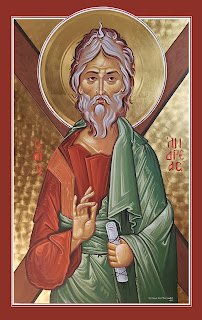The Gentle Mirror In St Andrew—The First-Called
T
hough he is only mentioned in the Gospels a few times, Andrew has proved himself to be a pivotal figure, despite being a second fiddle to his more famous brother, Simon Peter. When we say somebody is pivotal it means he is a crucial turning point. There are three pivotal lessons we can learn from Andrew's life.
Andrew, from the fishing town of Bethsaida, located on the northernmost coast of the Sea of Galilee, is a disciple of John the Baptist. We all know John the Baptist’s job is to point the way to Jesus, and he is good at it because his leading disciple, Andrew, when he says to him “Look, here is the Lamb of God!” (Jn 1:37) he and another disciple immediately follow Jesus. The two go out of their way to see and to stay where Jesus stays. Afterwards the first act of Andrew is to look for another person, who is no less than his own brother, “He first found his brother Simon and said to him, 'We have found the Messiah'" (Jn 1: 41). For this reason, Andrew is at times referred to as the “introducer.” Andrew brings his brother Simon (who would be renamed Peter by Jesus) to follow Jesus (Jn 1:37-42). Because Andrew is always mentioned after his brother Simon many have concluded that Andrew is much younger. But it could also be the other way around with Andrew being the firstborn. There were brothers before like Jacob and Esau, Isaac and Ishmael wherein the younger of the two outshone or overshadowed the firstborn.
The second pivotal characteristic of Andrew is his quickness in acting which is almost instinctual. There is another occasion that we see Andrew when Jesus performs one of his greatest miracles, the feeding of the five thousand. The people follow Jesus deep into the wilderness to hear him preach. Seeing the crowd tired and hungry, Jesus seeks to console their needs and commands the disciples to feed them. A nearly impossible task, the disciple Philip responds that two hundred days wages worth of food wouldn’t be enough for each person to have a little bit. However, Andrew responds by bringing another unlikely recruit to Jesus, “There is a boy here who has five barley loaves and two fish." But Andrew adds, as a matter-of-factly, "what good are these for so many?” (Jn 6:9). Like his fellow apostles, Andrew also has a share of blindness due to beliefs and biases. But despite his initial blindness, he is the one who recognizes the boy's provisions no matter how insignificant it maybe in the eyes of people like him. This becomes a pregnant occasion for Jesus's tipping-point. Malcolm Gladwell's debut book entitled, "The Tipping Point: How Little Things Can Make a Big Difference" defines a tipping point as "the moment of critical mass, the threshold, the boiling point." Andrew paves the way for Jesus's tipping-point bringing about not only the miracle of the multiplication of the loaves but also the miracle of super-abundance such that there are twelve wicker baskets of leftovers. Andrew has the instinct to bring others to Christ without full knowledge of what will happen next. For this reason, Andrew is at times referred to as the "networker" or even the "disinterested influencer"—someone who has a strong sway over a target audience with no hidden agenda. He simply obeys.
The third pivotal characteristic of Andrew is seen on the occasion just before the Lord’s Passion. A couple of Greeks approach Philip and ask to speak to Jesus. Philip refers the matter to Andrew and together they accompany the Greeks to Jesus. This is a significant event because Jesus had explicitly stated His ministry was first and foremost to the “lost sheep of the House of Israel." Andrew is again pivotal figure because he introduces the Greeks and the gentiles to have a share in Jesus's ministry too. Philip and Andrew were the only ones among The Twelve who had Greek rather than Hebrew names which was a common naming practice among Jews and Hellenized people at that time.
If John is touted as a "pointer," Andrew is an "intersection," a "meeting-point" just like a mirror or any medium through which reflections meet or enter. This mirror allows the light of Jesus to enter which is then reflected or passed on, first to his brother Simon Peter, then to the boy with five loaves and two fishes, and finally to the two Greeks. A mirror acts quickly with utmost transparency so as not to obstruct the way. In my current ministry of spiritual direction and retreat giving, St Andrew is a good role model to emulate when guiding people during retreats. He is first-called [Πρωτόκλητος, Prōtoklētos] among all the apostles. He shuns the limelight because he reflects the light. For one to effectively accomplish this one must become a disinterested meeting place. One must have the virtue of gentleness and tenderness. St Ignatius of Loyola considers this form of disinterestedness as a virtue. It is akin to what he calls "holy indifference." For Andrew's presence to become an effective meeting point for people to find Jesus, it must be a humble and tender presence, not threatening. If we survey the bible, it seems like he is not part of the inner circle of Jesus because we do not find him at the time when Jesus brings back to life Jairus's daugther, or at the Transfiguration, or at the Garden of Gethsemane. But it does not mean he is less of a disciple. We will not have Peter if it were not for the networking ability of Andrew. We can all emulate Andrew's quiet mirroring role—mirroring people to Jesus and mirroring Jesus back to them. Amen. Fr JM Manzano SJ


Gentle mirrors reflect the image and person of Christ in each person who looks through the mirror. We are blessed to find one like you. Deo gracias! Thanks for being one , Fr. JM!
ReplyDeleteThank you for your spiritual insight about the gentle mirror and the person who is looking at the same mirror. Both see the image of Jesus Christ! Thank you so much for your affirmation also! GBU! 😇
Delete